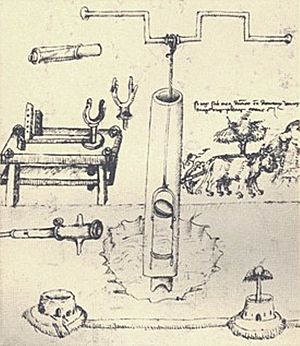Taccola facts for kids
Mariano di Jacopo (born 1382 – died around 1453), known as Taccola ("the jackdaw"), was a very talented Italian person from the early Renaissance. He was good at many things, like being an administrator, an artist, and an engineer.
Taccola is famous for his books about technology, called De ingeneis and De machinis. These books are full of drawings of new and clever machines and tools, with notes explaining them. Many engineers and artists who came after him, like Francesco di Giorgio and even Leonardo da Vinci, studied and copied Taccola's work.
Contents
Who Was Mariano Taccola?
Mariano Taccola was born in Siena, Italy, in 1382. We don't know much about his childhood or how he learned his skills. As an adult, he had many different jobs in Siena. He worked as a notary (someone who deals with legal documents), a secretary for the university, a sculptor, and even managed roads and water systems.
Around the 1440s, Taccola stopped working in his official jobs. He received money from the state as a pension. We know he joined a group called the "fraternal order of San Jacomo" by 1453. He likely passed away around that time.
Taccola's Amazing Books
Taccola created two important books, which are like early science and engineering textbooks.
De ingeneis (About Machines)
His first big book was called De ingeneis, which means "Concerning engines" or "About machines." He started working on its four parts as early as 1419. He finished the main part in 1433, but he kept adding new drawings and notes to it until about 1449.
De machinis (More Machines)
In 1449, Taccola also published his second book, De machinis, meaning "Concerning machines." In this book, he showed many of the same clever devices that he had developed for his first book.
His Drawing Style
Taccola drew his designs with black ink on paper. He added notes by hand to explain everything. His drawings show many "ingenious devices" for things like water engineering, milling (grinding grain), construction, and war machines.
Taccola's style was a mix of old and new. He drew about topics that later Renaissance artists and engineers would focus on. However, his way of drawing was still a lot like medieval manuscript art. For example, he didn't always use perspective correctly in his drawings. This is interesting because he was the only person known to have talked with Filippo Brunelleschi, who was famous for inventing linear perspective. Even with these drawing differences, Taccola's style is known for being strong, real, and good at showing the main idea.
Taccola's Lasting Influence
Taccola was sometimes called the "Sienese Archimedes" because he was so clever. His work helped start the tradition of Italian Renaissance artist-engineers. These were people who were both artists and engineers, and they became very interested in all kinds of technology.
Taccola's drawings were copied and inspired many others, including Buonacorso Ghiberti, Francesco di Giorgio, and possibly even Leonardo da Vinci. His drawings of clever lifting devices and special gear systems are very important. These were the systems Brunelleschi used to build the huge dome of the Florence cathedral. At that time, it was the second widest dome in the world!
After Taccola died, people didn't pay much attention to his work for a long time. This might be because his books were only hand-copied, and only a few copies survived. In the 1960s, Taccola's original books were found again in libraries in Munich and Florence. Their style was even more detailed than the copies. This discovery led to the first printed versions of De ingeneis and De machinis being published.
Gallery
See also
 In Spanish: Taccola para niños
In Spanish: Taccola para niños





